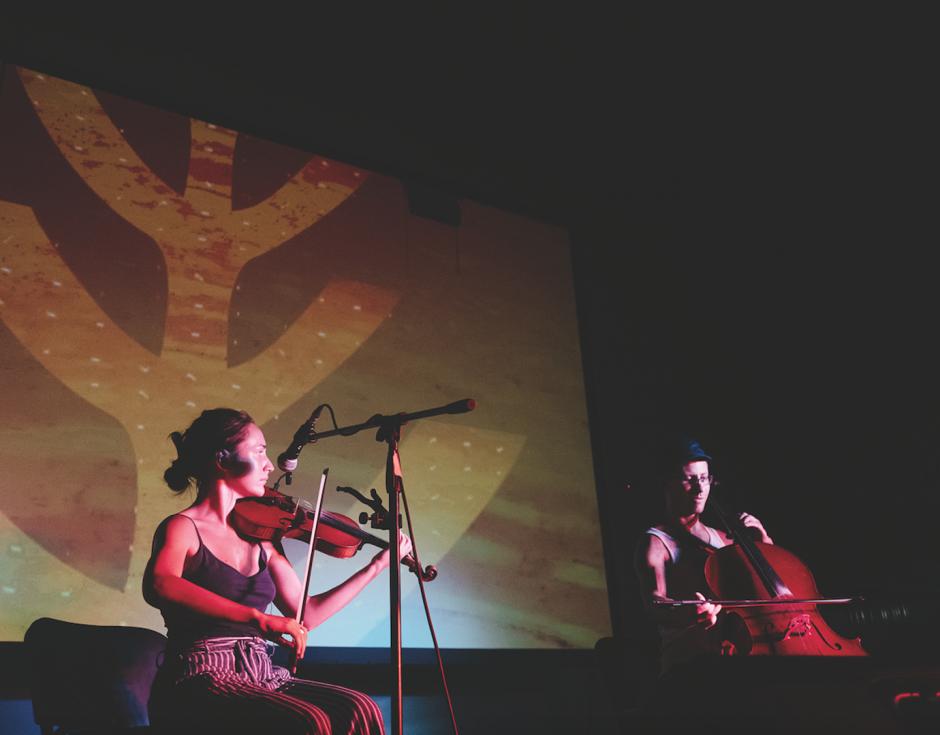Global Ear: Nalchik
December 2019

S’adouno at Summer Platform, Nalchik in The Wire 430. Photography by Max Kerzhentsev
Punk ethnography is thriving in the Caucasus. Stream a playlist of tracks from local label Ored Recordings, selected and annotated by writer Nikita Velichko
| Нагъой Заур “Псыхэгъэ” | 0:01:25 |
| Ашуг Шемшир “Medley” | 0:05:32 |
| Болатби Харон “Зама” | 0:04:31 |
| КIэрэф Темболэт “Хъырцыжь Алэ и уэрэд” | 0:02:06 |
| Бархъал “Арайн тIайлауккаву” | 0:02:08 |
| Дорҗин Татьяна болн Билцгин Мария “Сиврин дун” | 0:03:20 |
| Альбина Ходжева и Аминат Добагова “01” | 0:01:40 |
| Aydın Əliyev (Aidyn Aliyev) və Aslan Quliyev “Duy-Duy” | 0:06:03 |
| Ийнар “Голлу” | 0:02:11 |
| Унэрокъо Аскэрби “КъэкIозэпыт” | 0:01:50 |
| Azar Ensemble “Аурашаа” | 0:02:38 |
| Нэгэрэкъо Къызбэч “Гущэкъу орэд (жъыу)” | 0:01:11 |
| ГъукIэ Замудин “Мэзгуащ” | 0:01:21 |
| Хьакурынэхьаблэ ныожъхэр “Субхьанэкэ я Аллаху” | 0:03:25 |
| Arseny & Arkady Kagramyan “Untitled” | 0:03:47 |
Ored Recordings, based in Nalchik in southwestern Russian, works with traditional performers in the Caucasus and nearby regions. “You find some perfect music which is being created right here, right now,” says label co-founder Bulat Khalilov in The Wire 430. “The best concerts we've been to were our expeditions.” Active since 2013, Ored not only organises recordings and releases, but also performances, lectures and other means of connecting the region’s folklore with listeners. This playlist, with notes by Velichko, includes tracks from the label's Bandcamp, as well as some unreleased recordings.
Нагъой Заур “Псыхэгъэ” (Zaur Nagoy “Psykhege”)
This ceremonial melody is played on kamyl, which is a Circassian flute. According to legend, if a person drowned and their body couldn't be found, a performer went on a river bank, coming upstream at the head of the procession and playing the instrument. At the place when kamyl's sound disappeared, and a chicken stuck in performer's belt stopped crowing, the floater's body could be found. This track is from a solo live release by Zaur Nagoy.
Ашуг Шемшир “Medley” (Ashug Shemshir “Medley”)
An unreleased track recorded in South Dagestan. Ashug is a name for a poet-singer in the Caucasus; Shemshir represents a Lezgin variation of Ashug’s heritage. Centuries-old traditions are mixed here with trends evolved in the Soviet and post-Soviet epoch.
Болатби Харон “Зама” (Bolatbi Haron “Zama”)
Recorded after his retirement, the former director of the state gallery in Grozny plays dechig-pondar, singing songs based on Chechen poetry. The word zama means time, epoch. This is the late Soviet lyrical folklore of Chechens.
КIэрэф Темболэт “Хъырцыжь Алэ и уэрэд” (Tembolat Tkhashloko “Song Of Ale Khyrtzyzh”)
A song from the first Ored release, recorded during a ceremonial meal. Dedicated to Ale Khyrtzyzh, a hero of the Russo-Circassian War in the 18th–19th centuries.
Бархъал “Арайн тIайлауккаву” (Balkhar Ensemble “Lak Love Song”)
Balkhar is a high-mountain village (aul) in Dagestan where Laks live. Their local female ensemble performs professionally during official events, yet at the same time consisting of regular countrywomen. At the day of the recording they were looking after their gardens and houses, then gathering in the local administration building to sing together.
Дорҗин Татьяна болн Билцгин Мария “Сиврин дун” (Tatiana Dordzhieva & Maria Beltsykova “Sirvin Dun”)
This religious song is performed by two Kalmyk grandmothers, winners of various music competitions. It calls to celebrate nomadic holiday Tsagan Sar (white month), worshipping the deity Okon Tengri and hoping for the protection of the spiritual teacher Dalai Lama.
Альбина Ходжева и Аминат Добагова “01” (Albina Khodzheva & Aminat Dobagova “01”)
Another unreleased track from a record dedicated to Abazinian wedding melodies. Played by two Circassian sisters on the accordion and pkhachich (wooden clappers).
Aidyn Aliyev & Aslan Quliyev “Duy-Duy”
Azeri dance music, performed by a virtuoso accordionist Aydın and percussionist Aslan. Released in collaboration with KROT webzine.
Ийнар “Голлу” (Iynar “Gollu”)
A Balkar folk choir from a village called Tashly-Tara. Iynar (Eeinar) used to concentrate on pop, but recently switched to traditional music. Their repertoire consists of songs by Omar Otarov who was a renowned Balkar artist.
Унэрокъо Аскэрби “КъэкIозэпыт” (Askerbi Unaroko “Kakozapyt”)
This performer is one of the few alive people who know the authentic West Circassian style of playing harmonica.
Azar Ensemble “Аурашаа” (Azar Ensemble “Aurashaa”)
Azar is an ensemble of Abkhaz people from Turkey. They are descendants of Muhajir people who had to migrate to the Ottoman empire after the Russo-Circassian War. Their style wasn't influenced neither by a Soviet tradition nor by Georgian polyphonic singing. This is a track from yet unreleased OR 019 release called “Abkazian & Circassian Music From Turkey”.
Нэгэрэкъо Къызбэч “Гущэкъу орэд (жъыу)” (Kazbek Nagaroko “Gusheq Ored/Lullaby”)
Kazbek Nagaroko, a young and active performer, plays almost all traditional instruments and knows many ritual, historical and religious songs. This is a lullaby melody composed by himself played on kamyl.
ГъукIэ Замудин “Мэзгуащ” (Zamudin Guchev “Mazguash”)
Guchev is a very important figure in Adyghe culture and music – conversations with him were one of the main reasons Bulat Khalilov and Timur Kodzokov started the Ored label. This song was recorded while filming the documentary Bonfires And Stars, where Moscow based electronic musician Moa Pillar attempts to collaborate with Circassian musicians during his trip across Adygea and Kabardino Balkaria.
Хьакурынэхьаблэ ныожъхэр “Субхьанэкэ я Аллаху” (Khakurinokhabl Village Grandmothers “Subhana Ya Allahu”)
Zachir is a spiritual song within the Circassian tradition. Also called Dhikr, Zikr, Zekr etc, it exists among different people who follow Islam. Recorded in the mosque of Khakurinokhabl aul in Adygea.
Arseny & Arkady Kagramyan “Untitled”
An untitled, unreleased track by Armenians from Derbent, a city in South Dagestan. They usually perform dance folk-tunes typical for Armenian culture in different regions.
Read Nikita Velichko's full Global Ear report in The Wire 430. Subscribers to The Wire can access the full issue online via the digital archive.
Leave a comment